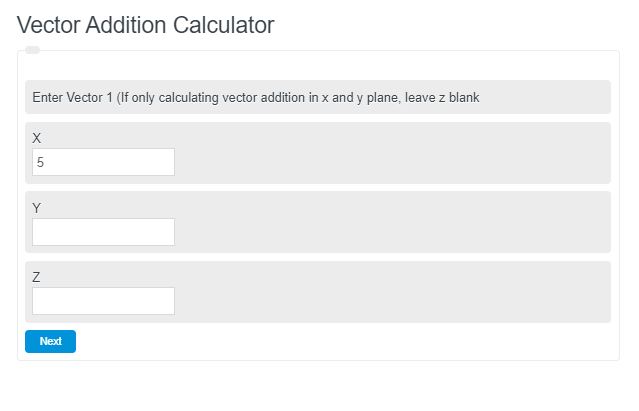Calculate the addition of two or three vectors. This vector addition calculator will determine the vector points, magnitude, and angle of the new vector.
- Unit Vector Calculator
- Midpoint Calculator
- Vector Subtraction Calculator
- Resultant Vector Calculator
- Angle Between Velocity and Acceleration Vectors Calculator
Vector Addition Formula
Vector addition involves adding each of the individual points on the vector to come up with new vector points. For example:
X (new vector) = X (vector 1) + X (vector 2)
How to add two vectors
The following is a step-by-step guide on adding vectors.
- The first step is to find the coordinates or values of each vector. For this example, we will assume the first vector is (1,2,3) and the second vector is (4,5,6)
- The next step is to add the coordinates of the corresponding vector. For example, the X-coordinate would be 1+4 = 5. The resulting vector is (5,7,9)
- Finally, analyze the results to make sure all of the calculations were performed correctly.
Vector Definition
A vector is an object used to describe direction and magnitude in the coordinate plane. They are typically drawn as arrows when represented in a certain space. They are used mostly in physics, specifically mechanics, to describe the motion of objects or forces on objects.
For example, imagine a bowling ball rolling across the ground. The ball is a velocity vector that tells us about its movement. It has a direction and magnitude.
This same bowling ball also has a vector to describe its momentum. It will have the same direction as the velocity, but the magnitude will be different since momentum is a combination of velocity and mass. However, since mass is a scalar quantity, it only affects the magnitude and not the direction.
As noted above, there are objects called scalars that are talked about in the same space as vectors. Scalars are simply a modifier of the magnitude of a specific vector.
FAQ
How do you calculate the magnitude of a resultant vector?
To calculate the magnitude of a resultant vector, you can use the Pythagorean theorem if the vectors are perpendicular. For vectors in general, you sum up the squares of the components of the resultant vector and then take the square root of this sum.
Can vector addition be used for vectors in three-dimensional space?
Yes, vector addition can be applied in three-dimensional space by adding the corresponding components of the vectors along the x, y, and z axes.
What is the significance of the direction of a vector in physics?
In physics, the direction of a vector is crucial as it indicates the direction of a quantity, such as force or velocity, acting upon an object. This helps in understanding and predicting the behavior of physical systems.
